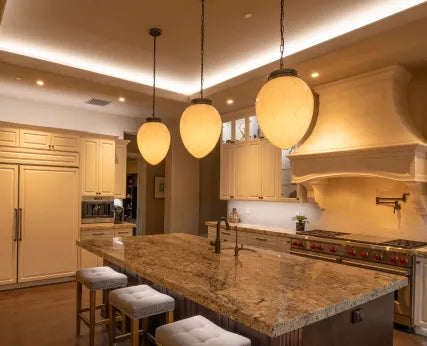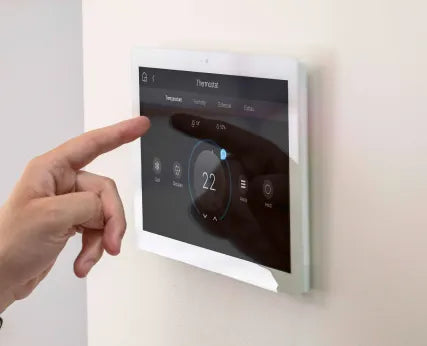Step into any modern home or office, and you’ll notice how technology is quietly transforming the way we interact with our environment. Among the most understated yet impactful devices on this front is the thermostat. No longer just a beige box on the wall that adjusts the temperature, thermostats have entered a new era. Welcome to the world of smart thermostats—a realm where energy efficiency, convenience, and personalized comfort come together.
But what really sets a truly smart thermostat apart from an ordinary "programmable" one? The answer lies in its ability to learn, adapt, and proactively optimize your environment. This guide will dive deep into everything you need to know to harness the power of HVAC automation, turning your space into a smarter, more efficient, and more comfortable haven.
What Is a Smart Thermostat and How Does It Work?
Simply put, a smart thermostat is a temperature control device that connects to your home’s Wi-Fi network. This connectivity is the key to its intelligence. It’s no longer an isolated controller but a smart hub within your home ecosystem.
Unlike traditional thermostats (manual temperature setting) or programmable thermostats (fixed schedules you enter), Wi‑Fi thermostats can:
- Be controlled remotely via a mobile app
- Use learning algorithms to understand your preferences and routines
- Leverage data from occupancy sensors and geofencing to determine whether anyone is home
- Integrate with voice control assistants like Alexa or Google Assistant for hands-free operation
In short, it can make smarter real-time decisions, providing comfort when you need it and maximizing energy efficiency when you don’t.
Not Just Convenient: Core Advantages of Smart Thermostats
Upgrading to a smart thermostat isn’t just about adjusting the temperature from your couch. For homeowners and property managers, it’s a strategic investment with tangible returns.
For Homeowners:
- Significant Energy Savings: By intelligently managing heating and cooling when no one’s home, smart thermostats can greatly lower your energy bills.
- Unmatched Comfort: The device anticipates your needs, ensuring you always return to a perfectly comfortable home.
- Improved Indoor Air Quality: Many models monitor humidity and can control ventilation systems, enhancing indoor air quality.
- In-depth Data Insights: With energy usage reports, you can understand your consumption patterns and find more ways to save.
For Property Managers:
- Centralized Control: Manage HVAC systems for multiple properties from a single platform, whether you’re overseeing apartment buildings or commercial real estate portfolios.
- Predictive Maintenance Alerts: Receive early warnings about potential HVAC issues before they become costly emergencies.
- Enhanced Tenant Satisfaction: Offer tenants modern, convenient amenities while keeping common area energy costs in check.
- Increased Property Value: Home automation is a compelling feature that attracts prospective buyers and tenants.
Unlocking Powerful Features: Must-Haves in Smart Thermostats
The real magic of smart thermostats lies in the synergy of advanced features.
- Learning Thermostat Capability: Top-tier devices learn your daily routines and automatically create personalized schedules. The more you adjust it, the more it understands your preferences.
- Occupancy Sensors and Geofencing: Occupancy sensors detect if someone’s in the room, while geofencing uses your phone’s GPS to know whether you're home, away, or heading back. When the house is empty, the thermostat shifts into energy-saving mode.
- Flexible Scheduling: Even without self-learning, intuitive apps let you set detailed daily or weekly schedules to suit your dynamic lifestyle.
- Voice Control: Connect your thermostat to a smart speaker and simply say, "Hey Google, set the living room to 72 degrees" to adjust the temperature.
- Remote App Control: Whether you’re on vacation or at the office, monitor and tweak your home’s temperature anytime via the mobile app.
Interactive Prompt: Which feature would benefit your household most—automatic learning, or remote control via your phone?
Compatibility Is Key: Will Your HVAC System Work?
Before buying, confirming compatibility is crucial. Fortunately, modern smart thermostats are designed to work with most HVAC systems.
- HVAC Types: Most units are compatible with traditional forced-air systems, heat pump-optimized systems, multi-stage units, oil furnaces, boilers, and radiant in-floor heating.
- Zoning: If your home is divided into multiple temperature zones, you’ll want a smart thermostat system that supports zoning for independent control of each area.
- C Wire: Smart thermostats usually require constant power, typically supplied by a “C wire” or common wire. Older homes may not have this wire.
Pro Tip: Not sure if your system is compatible? Snap a photo of your current thermostat wiring. Linko Smart Technology experts can help you confirm compatibility quickly. Contact us now for a free consultation!
Installation Considerations: Secrets to a Smooth Setup
While tech-savvy users can sometimes handle smart thermostat installation themselves, professional installation ensures optimal performance and safety.
- Location Matters: Install the thermostat on an interior wall, away from direct sunlight, air vents, and doors or windows for accurate readings.
- Wiring Check: Proper identification and connection of all wires, especially the C wire, is vital. Incorrect wiring can damage your thermostat or HVAC system.
- Network Setup: Ensure the thermostat links reliably to your Wi-Fi for remote access and software updates.
- Initial Configuration: A pro will help with setup, including entering your basic preferences and pairing with your mobile app.
Getting the Most Out of It: Smart Thermostat Best Practices
Installation is only the first step. To truly maximize energy savings, develop effective usage habits.
- Trust the Device: Resist the urge to constantly adjust settings manually. Let your learning thermostat do its job.
- Set Reasonable Energy-Saving Temperatures: When away or sleeping, set the temperature a few degrees higher or lower than your comfort level. Every degree you adjust adds up to significant savings.
- Use Vacation Mode: Always activate vacation or away mode for extended absences.
- Review Your Energy Reports: Check usage reports regularly to see how long your HVAC system runs and spot more ways to optimize.
Measuring ROI: From Data to Dollars Saved
How do you quantify your return on investment? You’ll need a data-driven framework.
- Establish a Baseline: Gather the last 12 months of energy bills before installation to understand your typical consumption.
- Track Key Performance Indicators (KPIs):
-
- kWh Saved: Compare energy usage after installation with your baseline.
- Runtime Reduction: Quality thermostats report how much less time your HVAC system runs.
- Comfort Score: Some platforms even offer a "comfort score" to ensure savings don’t come at the expense of your comfort.
- Leverage Utility Rebates and Demand Response: Many utility companies offer rebates to encourage energy-efficient upgrades. Plus, enrolling in demand response programs, which allow short-term thermostat adjustments during peak times, brings extra incentives.
The Future of Temperature Control: Trend Watch
Smart thermostat technology keeps evolving.
- AI Integration: Future devices will combine more datasets—weather forecasts, real-time grid pricing—to make even smarter decisions.
- Grid-Friendly Devices: Thermostats will actively communicate with the grid, helping balance loads and favor operation during off-peak hours.
- Deeper Health Integration: Expect closer integration with air purifiers and humidifiers for holistic indoor environment management.
Partnering with Linko Smart Technology
A successful smart thermostat deployment isn’t just about buying a device. It demands a holistic approach—consultation, hardware choice, professional smart thermostat installation, configuration, and ongoing support.
At Linko Smart Technology, we’re your end-to-end solution experts. We start by understanding your unique needs, recommending the best hardware, delivering seamless installation, and making sure you tap into the full power of your new system.
Ready to make your home smarter, more comfortable, and energy efficient? Contact Linko Smart Technology today for a free consultation or to schedule a pilot project.
Frequently Asked Questions (FAQ)
1. How much does it cost to install a smart thermostat?
Costs vary by model and installation complexity. However, factoring in energy savings and potential utility rebates, many users recoup their investment in 1–2 years. We focus on value, not just price.
2. Will my older HVAC system be compatible?
The vast majority of systems are compatible. The critical factor is wiring, especially the presence of a C wire. Our technicians can evaluate and advise you during your consultation.
3. How long does installation take?
For an experienced technician, a standard installation usually takes 60–90 minutes, including setup and mobile app pairing.
4. How much energy can I actually save?
Savings depend on your climate, home insulation, and usage habits. Industry studies indicate average users can save 10–20% on heating and cooling costs.
5. Is my usage data secure? How is privacy protected?
We prioritize your data security and privacy. All data is encrypted during transmission and storage. We follow strict privacy policies and never share your personal information without your explicit consent.
6. Do smart thermostats require maintenance?
The device itself requires little maintenance. We push feature and security updates automatically via software. Plus, predictive maintenance features can remind you to change filters or schedule annual HVAC service.




